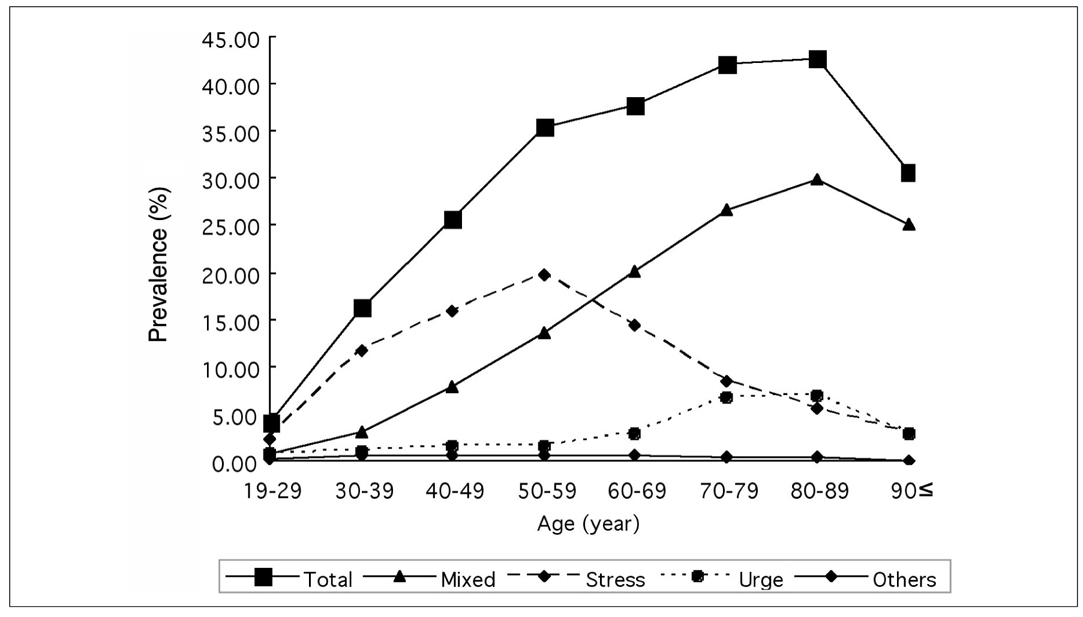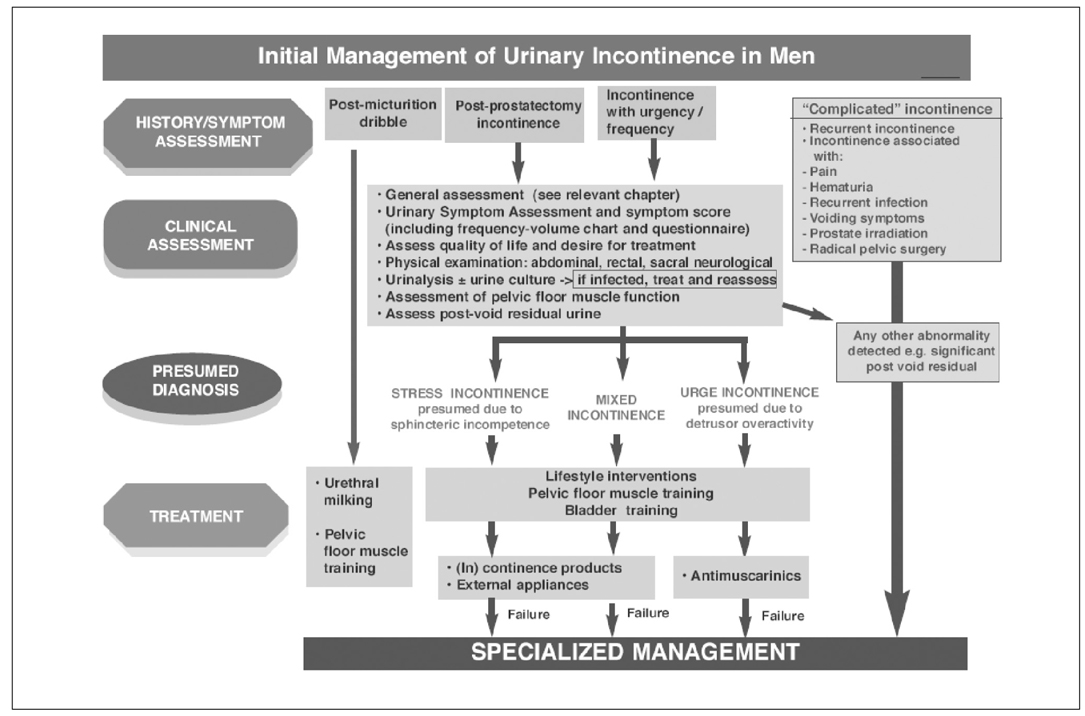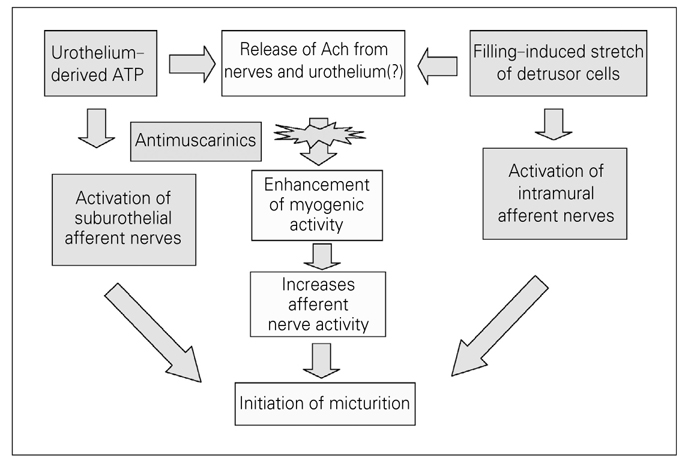J Korean Med Assoc.
2007 Nov;50(11):1025-1036. 10.5124/jkma.2007.50.11.1025.
Pharmacological Therapy for Urinary Incontinence
- Affiliations
-
- 1Department of Urology, Sungkyunkwan University School of Medicine, Korea. ksleedr@skku.edu
- KMID: 2184950
- DOI: http://doi.org/10.5124/jkma.2007.50.11.1025
Abstract
- Urinary incontinence is an important lower urinary tract symptom that negatively affects the quality of life. Urgency incontinence (UI) is urine loss accompanied by urgency, which is the chief complaint of overactive bladder (OAB) syndrome. OAB is defined as urgency, with or without UI, usually with frequency and nocturia. In contrast, stress urinary incontinence (SUI) involves involuntary urine leakage caused by a sudden increase in abdominal pressure. Treatment for urinary incontinence depends on the type of incontinence, the severity, and the underlying causes. Treatment options fall into four broad categories: lifestyle intervention, bladder retraining and/or pelvic floor muscle training, pharmacotherapy, and surgery. Pharmacotherapy is often the first-line therapy for OAB/UI, either alone or as an adjunct to various nonpharmacological therapies. Effectiveness of anticholinergic drugs for OAB/UI has been assessed in various observational and randomized controlled trials. Despite their side effects, anticholinergics are the first-line agents for UI. Tricyclic antidepressants have complex pharmacological actions such as anticholinergic, alpha adrenergic, antihistaminic, and local anesthetic properties. Recently approved anticholinergics, solifenacin and darifenacin, are selective M3 antagonists that may have tolerable side effects. Transdermal oxybutynin may offer comparable efficacy with oral formulation but lower side effects. In the absence of an effective and well tolerated drug for SUI, pharmacological therapy for this condition has remained in the off-label prescription of some products, particularly estrogens and alpha-adrenergic agonists. Duloxetine is the drug of choice specifically aimed at SUI. This article outlines the current state and future development in pharmacological therapy for urinary incontinence.
MeSH Terms
-
Adrenergic alpha-Agonists
Antidepressive Agents, Tricyclic
Cholinergic Antagonists
Drug Therapy
Duloxetine Hydrochloride
Estrogens
Life Style
Nocturia
Pelvic Floor
Prescriptions
Quality of Life
Solifenacin Succinate
Urinary Bladder
Urinary Bladder, Overactive
Urinary Incontinence*
Urinary Tract
Adrenergic alpha-Agonists
Antidepressive Agents, Tricyclic
Cholinergic Antagonists
Estrogens
Figure
Cited by 1 articles
-
Lower urinary tract dysfunction in the elderly
Kyu-Sung Lee
J Korean Med Assoc. 2015;58(10):866-867. doi: 10.5124/jkma.2015.58.10.866.
Reference
-
1. Abrams P, Cardozo L, Fall M, Griffiths D, Rosier P, Ulmsten U, Van Kerrebroeck P, Victor A, Wein A. The standardisation of terminology in lower urinary tract function: Report from the standardisation sub-committee of the International Continence Society. Urology. 2003. 61:37–39.
Article2. Andersson KE, Appell R, Cardozo L, Chapple C, Drutz HP, Finkbeiner AE, Haab F, Vela Navarrete R. Abrams P, Cardozo L, Khoury S, Wein A, editors. Pharmacological treatment of urinary incontinence. Incontinence, 3rd International Consultation on Incontinence. 2005. 21th ed. France: Health Publication Ltd;811–854.3. Nitti VW, Raz S. Obstruction following anti-incontinence procedures: Diagnosis and treatment with transvaginal urethrolysis. J Urol. 1994. 152:93–98.
Article4. Lee KS, Choo MS, Kim DY, Kim JC, Kim HJ, Min KS, Lee JB, Jeong HJ, Lee T, Park WH. Combination treatment with propiverine hydrochloride plus doxazosin controlled release gastrointestinal therapeutic system formulation for overactive bladder and coexisting benign prostatic obstruction: a prospective, randomized, controlled multicenter study. J Urol. 2005. 10. 174(4 Pt 1):1334–1338.
Article5. Thor KB, Katofiasc MA. Effects of duloxetine, a combined serotonin and norepinephrine reuptake inhibitor, on central neural control of lower urinary tract function in the chloralose-anesthesized female cat. J Pharmacol Exp Ther. 1995. 274:1014–1024.
- Full Text Links
- Actions
-
Cited
- CITED
-
- Close
- Share
- Similar articles
-
- Oral pharmacological therapy for urinary incontinence
- Diagnosis and therapy for functional urinary incontinence in childhood
- Diagnosis and Treatment of Urinary Incontinence in Female Patients
- The Efficacy of Periurethral Injection Therapy for Female Stress Urinary Incontinence
- Two Cases of New Operative Technique in Treatment of Stress Urinary Incontinence





